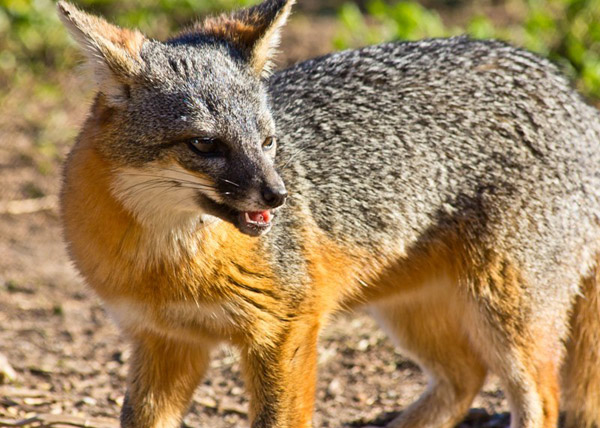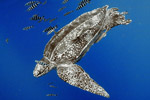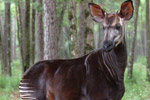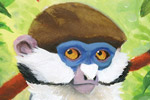The number of threatened species on the IUCN Red List has grown by 352 since this summer, according to an update released today. Currently, 21,286 species are now listed as threatened with extinction out of the 71,576 that have been evaluated. The new update comes with both good and bad news for a number of high-profile imperiled species, but only covers about 4 percent of the world’s described species.
The condition of the shy and elusive okapi—the only living relative of the giraffe—has degraded. Found only in the Democratic Republic of the Congo, the okapi (Okapia johnstoni) has been moved from being listed as Vulnerable to Endangered.
Meanwhile, the white-winged flufftail (Sarothrura ayresi) has been moved from Endangered to Critically Endangered, the most threatened category before extinction. Found in South Africa, Ethiopia, and Zimbabwe, the beautiful red-and-black bird is now one of the most imperiled birds in Africa with only an estimated 250 individuals left.
 Okapi. Photo by: Bob Jenkins. |
Still, the news was not all bad. The leatherback sea turtle’s (Dermochelys coriacea) status has been downgraded from Critically Endangered to Vulnerable. The world’s largest marine turtle, the leatherback had been listed as Critically Endangered since 2000. Two albatross have also seen their conditions recover. Conservationists moved the black-browed albatross (Thalassarche melanophrys) from Endangered to Near Threatened, and the black-footed albatross (Phoebastria nigripes) from Vulnerable to Near Threatened. Sea birds are among the world’s most imperiled birds, and the albatross family—which is gravely imperiled by bycatch in industrial fisheries—is the most threatened of all.
But California’s island fox (Urocyon littoralis) may have made the biggest recovery in the update: jumping all the way from Critically Endangered to Near Threatened. Found on the California Channel Islands, the species has been brought back from the brink by the U.S. National Park Service after being decimated by non-native predators and disease.
“This IUCN Red List update shows some fantastic conservation successes, which we must learn from, for future conservation efforts,” says Jane Smart, Global Director, IUCN Biodiversity Conservation Group. “However, the overall message remains bleak. With each update, whilst we see some species improving in status, there is a significantly larger number of species appearing in the threatened categories. The world must urgently scale up efforts to avert this devastating trend.”
The IUCN Red List is the world’s top authority is species’ endangerment. However, while it has currently evaluated over 70,000 species including almost all of the world’s mammals, birds, and amphibians, the vast majority of the world’s species remain unevaluated. To date, scientists have described nearly 2 million species on Earth with several million more expected to be discovered. Efforts to rapidly scale-up, the IUCN Red Lists assessments and monitored have been hampered by lack of funding.
Scientists have been warning for decades that the world may already be facing, or will soon face, a mass extinction crisis due to human impacts such as deforestation, pollution, overconsumption, ecosystem destruction, population growth, and climate change among others.

The island fox has made a stunning recovery. Photo by: Guy Incognito.

Black browed albatross. Photo by: Alan Tate (worldsrarestbirds.com).

Leatherback sea turtle. Photo by: Guy Marcovaldi.
Update on the IUCN Red List
- Extinct = 799
- Extinct in the Wild = 61
- Critically Endangered = 4,286
- Endangered = 6,451
- Vulnerable = 10,549
- Near Threatened = 4,822
- Total Lower Risk/conservation dependent = 241 [this is an old category that is gradually being phased out of the Red List]
- Least Concern = 32,486
- Data Deficient = 11,881
Related articles
Leatherback sea turtle no longer Critically Endangered

(11/26/2013) The leatherback sea turtle—the world’s largest turtle and the only member of the genus Dermochelys—received good news today. In an update of the IUCN Red List, the leatherback sea turtle (Dermochelys coriacea) has been moved from Critically Endangered to Vulnerable. However, conservationists warn that the species still remains hugely endangered—and in rapid decline—in many parts of its range.
Elusive giraffe-relative – the okapi – now listed as Endangered

(11/26/2013) The discovery of the okapi shocked the world in 1901. African explorer, Henry Stanley, called it ‘donkey-like,’ while others thought it a new species of zebra, given the stripes. However, this notoriously-secretive rainforest ungulate proved to be the world’s only living relative of the giraffe, making it one of most incredible taxonomic discoveries of the Twentieth Century as well as one of the last large-bodied mammals to be uncovered by scientists. But the future of the okapi (Okapia johnstoni) is increasingly in doubt: a new update of the IUCN Red List released today has raised the threatened level for the okapi from Vulnerable to Endangered.
Microhabitats could buffer some rainforest animals against climate change
(11/25/2013) As temperatures increase worldwide due to anthropogenic climate change, scientists are scrambling to figure out if species will be able to survive rapidly warming ecosystems. A new study in Global Change Biology offers a little hope. Studying reptiles and amphibians in the Philippines, scientists say some of these species may be able to seek refuge in cooler microhabitats, such as tree holes or under the soil, in order to stay alive during intensifying heatwaves. But, the scientists’ stress, the shelter from microhabitats can only protect so far.
New children’s book celebrates the rich wildlife of Kibale National Park

(11/25/2013) There are many ways in which people practice conservation. The most well-known are working to save species in the field or setting up protected areas. But just as important—arguably more important for long-term conservation success—is conservation education, especially with children. Anyone who grew up watching David Attenborough documentaries, reading Gerald Durrell books, or simply exploring ecosystems on their own can tell you how important it is to encounter the wonders of wildlife at a young age. And for many of us most of our first encounters with wild animals are in illustrated books. Eric Losh’s new book, The Chorus of Kibale, not only provides an educational opportunity for children to become acquainted with the many animals in Kibale National park in Uganda—through wonderful pictures and sounds—but proceed also go directly to two conservation groups working in the region, U.N.I.T.E. for the environment and the Primate Education Network (PEN).
Strange mouth-brooding frog driven to extinction by disease

(11/21/2013) An unusual species of mouth-brooding frog was likely driven to extinction by the fungus Batrachochytrium dendrobatidis (Bd), making an unusual example of ‘extinction by infection’, argue scientists writing in the open-access journal PLOS ONE. Rhinoderma rufum has not been seen in the wild since 1980.